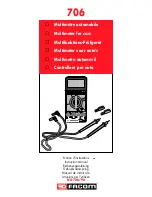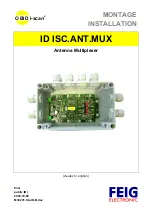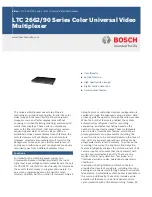
-
19
-
in the exhaust stream this voltage is used by the computer to change the
air/fuel mixture.
This test will check oxygen sensor signal output levels.
·
Disconnect the vehicle wiring harness at the sensor. Install a jumper wire.
·
Select the voltage range with the rotary switch.
Insert:
·
Black lead in COM terminal.
·
Red lead in V/
Ω
/RPM terminal.
·
Connect the test probes in parallel:
positive (+) to the jumper wire, negative (-)to the engine ground.
·
Vehicle engine must be running at operating temperature (fast idle at
2000RPM for two minutes).
Voltage readings should move between 0.2(lean) and 0.8 (rich). The average
DC voltage should be around 0.50.
[5] Pressure sensor Test
The electrical tests for pressure sensor such as the Manifold Absolute Pressure
(MAP) and Barometric Pressure (BARO) vary greatly, depending upon type and
manufacturer, consult the vehicle service manual for the schematic,
specifications and test procedures.
General Testing Procedures
Note : You cannot do a resistance (
Ω
) test for pressure sensors.
Analog Sensor
An analog sensor can be tested with the same series of voltage (V) tests
suggested for 3-wire potentiometet voltage tests. In place of
“sweeping” the
sensor, a vacuum pump is generally used to vary the pressure on the sensor. In
all cases, refer to a vehicle service manual for the correct procedure.
Component Test (Output)
Output Devices
The electrical tests for output devices vary greatly, depending upon type and
manufacturer. Consult the vehicle service manual for the schematic,
specifications and test procedures.
Primary output devices (actuators) are from of an electromagnet that is either
ON/OFF. The ON/OFF signal, in general, will be in one of three configuration:
·
ON/OFF only (switch)
check for continuity with the switch in the ON and OFF
position.
·
Pulse width (fuel injector)
measure the ON time (pulse).
·
Duty cycle (Mixture Control Solenoid)
measure the percent of high (+) or
low (-) time in a duty cycle. In most cases the low (-) time is the on time.
Maintenance Fuse and Battery Replacement
WARNING:
·
Avoid electrical shock; remove test leads before opening case.
·
Do not operate the meter or rotate the meter switch when the case is open.
1. To replace a battery or fuse, loose the four screws in the case back and
remove the case by lifting up and forward.
·
Replace the battery with an 9 volt alkaline battery.
2. To replace fuse, firmly grasp the printed circuit board (PC boards by the
edges and lift up and out of the case.
IMPORTANT:
·
To prevent contamination of the circuits, your hands must be clean and the
printed circuit board must be help by the edges.
·
Replace the fuse with the same type of fuse.
◎
10A is a F10A ,250V high energy, fast acting fuse.
◎
mA is a F500mA, 250v high energy, fast acting fuse.
·
Mark sure the replacement fuse is centered in the fuse holder.
3.Carefully re-insert the PC boards into the case. Re-assemble the case, then
fasten the four screws.
Trouble Shooting
1.Meter will not turn ON.
·
Check the battery contacts for a tight fit.
·
Check for a minimum battery voltage of 8.0 volts.
·
Mark sure the battery wire, are not pinched in the cafe.
2. Ampere reading is erratic or there is no reading at all.
·
Disassemble the meter back cover and test the fuses for continuity.
3. Meter reading is erratic.
·
Printed circuit board contaminated from handling with hands.
·
Low battery.
·
Open circuit in a test lead (frayed or broken wire).
·
Wrong range selected.
·
For frequencies below 1Hz, the display will show 00.00Hz.
·
“Blown” fuse.


































